Menus
- Noriyuki Haga’s motorcycle from WSBK 2000
- 4 cylinders in line, 749 cm3, 172 hp, 162 kg dry
- Discovery
- Test
- Cycle part
- Braking
- Conclusion
Noriyuki Haga’s motorcycle from WSBK 2000
4 cylinders in line, 749 cm3, 172 hp, 162 kg dry
The four-year racing ban imposed on Andrea Iannone, now a former MotoGP rider of Aprilia following his positive steroid test, triggers an inevitable step back in the history of motorcycle racing. Exactly 20 years ago, Yamaha rider Noriyuki Haga also tested positive. And this profoundly changed the fight for the title of World Superbike Champion. We were then at the first event of the season in South Africa. During the offseason, Nori-chan had embarked on an extensive fitness program that allowed him to present to Kyalami with 15 pounds lighter. He then used a commercially available dietary supplement to help him, Ma Huang, but the latter contained a higher concentration of ephedrine than allowed by FIM regulations. Despite Yamaha’s efforts to have the decision overturned on appeal, the Japanese’s victory in Race 2 was effectively canceled and the Japanese was forced to miss the final Brands Hatch event, sacrificing 75 theoretical points during this year in which despite everything he finished runner-up … 65 points behind Colin Edwards…
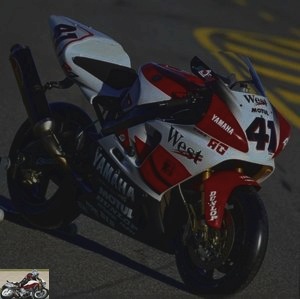 Test of the Yamaha YZF-R7 OW-02
Test of the Yamaha YZF-R7 OW-02
Discovery
The machine which is widely regarded as the most desirable Japanese motorcycle ever produced with an inline-four thus failed to win the World Championship for which it was created. For the 1999 season, Yamaha had indeed finally taken the Superbike seriously by presenting the limited edition YZF-R7 OW-02 alongside the R6, its brand new contender in the 600 Supersport. Yamaha thus not only responded to the challenge presented by Honda’s four-stroke and its European rivals, but also allowed R&D director Kunihiko Miwa to declare "The family is now complete!" . And that was the case, 12 months after the launch of the radical one-liter R1.
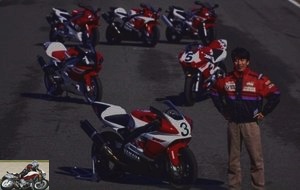 The YZF-R family as a whole
The YZF-R family as a whole
But with R7 production expected at just 500, the minimum number for WSBK homologation, carried out in one batch for worldwide distribution, Yamaha’s intentions for the R7 were clear. Rather than downsizing to produce a mini R1 that could compete with the Suzuki GSX-R 750, Yamaha had followed the lead of Ducati and Aprilia by producing an expensive uncompromisingly homologated motorcycle for Superbike racing, marketed as a racing motorcycle. road to meet the regulations, but with the hope that most motorcycles would end up on the track to wave the Yamaha flag globally and nationally.
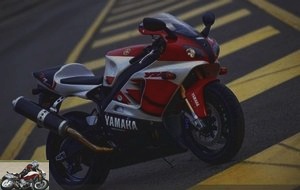 The Yamaha YZF-R7 road
The Yamaha YZF-R7 road
However, when the World Superbike resumed in 2001 in Valencia, Haga and his R7 were absent. Because Yamaha had shown its displeasure at having lost the world title the previous year by interrupting its direct involvement started a year earlier, sending Nori-chan to learn the rules of the 2-stroke GP on the YZR500 in preparation for his next campaign of 2002 on the OW-M1 prototype of 942 cm3 4-stroke. Haga therefore followed orders to fall back to 500GP, even when his heart pushed him to stay to fight for the title, in a classic scenario of the man torn between his fate and his desires, pure Hollywood….
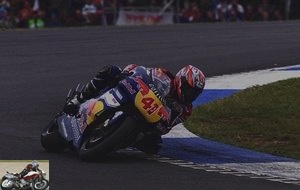 In 2001, Haga had to take charge of the Grands Prix
In 2001, Haga had to take charge of the Grands Prix
Four cylinders against twin, Japan against USA, Yamaha against Honda, Dunlop against Michelin. The WSBK 2000 struggle for supremacy between Texas Tornado (Edwards) and Sultan of Slide (Haga) offered a real battle of opposition. And the fact that the controversial penalty imposed on Haga deprived racing fans of an epic final, ultimately did not detract from the thrilling spectacle offered by these two Superbike superstars throughout the season, on two very different motorcycles..
Just a few weeks after getting a taste of the V-twin of the championship-winning Honda SP-01W at the Motegi circuit, I had the chance to do the same with Haga’s R7 in Jerez. There are privileges that we cannot refuse !
 Haga’s Yamaha YZF-R7 OW-02
Haga’s Yamaha YZF-R7 OW-02
The 749cc R7 engine at 62.4 kg (compared to 65.7 for the then R1) was an all-new model featuring electronic fuel injection for the first time on a Yamaha sports car. It retained the 72 x 46 mm dimensions of the old YZF750, as well as its 20-valve format with three intake valves and two exhausts per cylinder, but now with chain drive shifted to the two overhead camshafts and with a high compression ratio of 14.2: 1. The reduced inertia of the stock titanium valves, coupled with the lightweight crankshaft and forged pistons allowed the engine to rev up quickly. The six-speed gearbox featured the same layout as on the R1 with an extractable cassette-type gear group allowing gears to be varied at will..
 The 749 cc 4 cylinder engine was specially designed to win the title
The 749 cc 4 cylinder engine was specially designed to win the title
The R7 bearing the "Nori" stickers, with a tracer bullet and Kenisuke’s name underneath (that of his older brother, paralyzed after a fall at Sugo in 1996), now presented an impressive package freed from its arrival problems. the power and instability under braking that I had been able to identify on the prototype two years earlier, already in Jerez. But the choice of the configuration of the cylinder part was undoubtedly unique and helped to highlight this spectacular driving style which made him a hero on both sides of the Atlantic, but also at home..
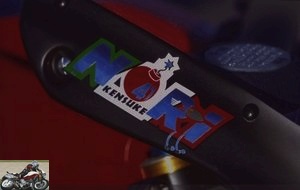 The R7 of ‘Nori’ has evolved well in a few months
The R7 of ‘Nori’ has evolved well in a few months
The R7’s static ride height is quite high. The whole thing is topped by a thick saddle pad used by Haga which returned a large part of your body weight to the wide handlebars and therefore to the front tire. In addition, it used very smooth suspension settings that generate significant travel through this high height. According to his racing engineer Roberto Brivio, Haga has always spent a lot of time training on each circuit to properly set up his Yamaha, making countless changes to fine-tune the distribution:
Nori-chan is very sensitive to any changes we make to the bike and he really enjoys experimenting with the steering geometry as well as the suspension setup. He knows what he is looking for and when he finds it, he gives everything for victory. He’s a much more technical rider than you might expect considering how carefree he seems to be riding. But everything is carefully planned and calculated. And he often makes a major adjustment to the setup between the two races. He knows what he’s doing.
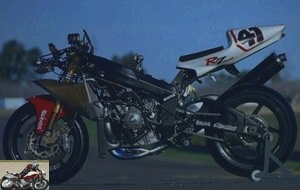 The Japanese pilot was a fine tuner
The Japanese pilot was a fine tuner
It even went so far as to change the position of the swingarm pivot between races in 2000, as could be done on the chassis of the R7 derived from the YZR500, or to experiment with one or the other of the three lengths. different swingarms the team had, all to adjust the grip characteristics to then find exactly the right choice of Dunlop tire which was also a key factor in Haga’s success in 2000 after the Michelin with which he had so much. struggled the previous year. Although he ended up adopting the rounder profile of the British compounds, compared to the pointed Japanese Dunlops with which he evolved in racing and chose to ride with 16.5 "which were then standardized in the range, Nori-Chan has many experimented with alternatives. This included testing the 16.25 inch tires at different times of the season, but also a new 200 rear tire, always with the objective of helping it achieve its goal: sooner and stronger than anyone.
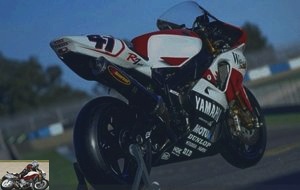 After struggling with his tires, Haga switched to Dunlops in 2000
After struggling with his tires, Haga switched to Dunlops in 2000
Running alone with the WSBK factory team in 2000, Haga had the advantage of targeted development on his bike by Yamaha’s racing department. Compared to all the R7s I have been able to ride, whether it was the first prototype, the 1999 press launch or Vitto Guareschi’s development bike, this special attention translated into vastly superior performance..
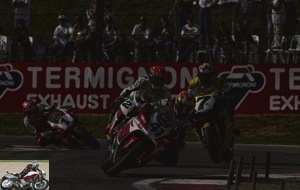 Haga leading the famous Kyalami race
Haga leading the famous Kyalami race
Test
Riding Nori-chan’s motorcycle factory in Jerez highlighted the chasm between the two motorcycles. It must be said that the bike received a constant flow of new parts throughout the season coming directly from Iwata. Haga’s bike had more of an appetite for high revs than a racing-equipped R7, but without sacrificing low-end torque for slow corners, like the last one before the pit straight at Jerez.
The engine responds cleanly from 6,000 rpm, offers good power from 8,000 rpm, but goes up to power above 10,000 by accelerating copiously to the limit of 15,500 rpm, a switch that Haga triggered all the time. race. But although the peak power of 172 hp is delivered as early as 13,800 rpm, it does not weaken significantly for at least 1,500 rpm, which means that one can push up the gears to save a few gear changes between turns, just like on a GP.
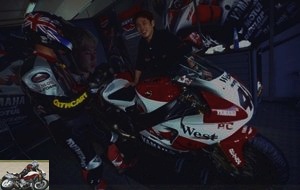 In discussion with Nori in the stand
In discussion with Nori in the stand
On the other hand, there is no gear change indicator like on other factory superbikes. "I don’t like it, I only change the feeling," Nori-chan said. So when you crank the Yamaha Powershifter a little below 15,000 rpm, thanks to the relatively closed internal gear ratios, you still find yourself in the big part of the power band as the R7 engine screams passionately through. the Akrapovic exhaust in titanium. Correction, we crush the gear lever, because the change of ratio of the R7 is very hard. In fact, I initially thought that the PowerShifter wasn’t on until I stopped at the pits to verify that it was. The problem apparently was that I was using the racing engine built for the last event at Brands Hatch, but never used due to the last minute ban for Haga and the shifter was not yet properly connected to this new engine..
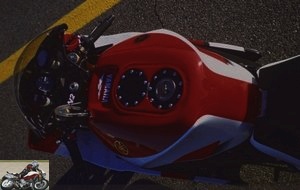 Haga driving noise, this superbike is devoid of gear change indicator
Haga driving noise, this superbike is devoid of gear change indicator
For a four in line at high revs, the Yamaha has a lot of muscle at medium revs, which makes it possible to be less demanding on the choice of the ratio for a given turn, thanks to the wide distribution of the power and its linear arrival. . And when you close the accelerator to brake before the turn, it is only in first gear that you experience a jerk when going around, a feature that was very intimidating on the 1999 R7. So I didn’t use it and instead relied on the power boost in the middle to get out of a slow turn like Dry Sack or the last turn..
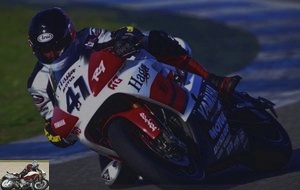 Online 4 offers a lot of mid-range rebound
Online 4 offers a lot of mid-range rebound
The Yamaha went from a single injector with Miuni throttle bodies and an ECO Nippondenso to a dual injector format with Keihin hardware and a Mitsubishi ECU. This change completely transformed throttle response and control, while delivering more power in a smoother manner. This change also involves a redesign of the fully sealed, carbon-coated 15-liter airbox with separate ducts internally, along with a different wiring harness and throttle harness, but the game is worth the effort. : the Yamaha not only has a lot more power across the rev range, but you can also feel more punch in the midrange.
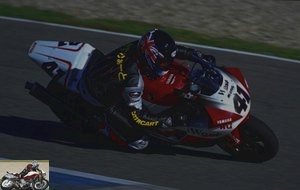 The arrival of power is now much more exploitable
The arrival of power is now much more exploitable
Coming out of the second right-hand turn in Jerez, I shifted faster, around 12,000, to pass the next two lefts while maintaining speed until the short straight, leaving the engine to howl until more of 15,000 turns. This kind of power arrival is very efficient, because the R7 now has really impressive acceleration, where it barely had before. This ability to climb the towers is also highly addictive and brings the Yamaha closer to a 2-stroke GP 500 than any other superbike..
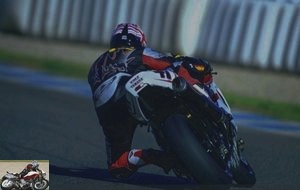 The acceleration is impressive, especially when exiting a curve
The acceleration is impressive, especially when exiting a curve
It’s not me who says it, but Christian Sarron, the only European of the 80s who managed to beat the Americans in a V4 500, after a dozen laps on the R7:
I’ve never liked riding Superbikes before, even at the Bol d’Or or the 24 Hours of Le Mans. They always seem so big and heavy and full of compromise, so it was more like a task I had to complete. But this is different, it is small and agile, the closest thing to a 500GP motorcycle that I have been able to ride. It has explosive power which makes it fun to fly, but also very efficient..
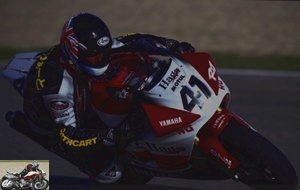 Haga tweaks bring the R7 closer to GP in handling
Haga tweaks bring the R7 closer to GP in handling
That improved horsepower, along with the Dunlop tires, was a big factor in keeping Haga so in good shape that year, winning four races in 2000 against just one in 1999, not to mention his withdrawn victory. South Africa.
The handling of the R7 is also more precise than that of Carlos Checa’s YZR500 which I rode the same day, so straightforward and easy by four-cylinder Superbike standards. This fact was further accentuated by Nori-chan’s very light steering damper adjustment. A point that also led to some intense moments when I cranked up the throttle and lifted the front wheel out of one of Jerez’s many tight corners in second or third gear. Sign of a very good R7 chassis setup, when the wheel touched the ground and the handlebars crossed as I frantically tried to steer it during this wheelie. But there was only one stroke of the handlebars and the bike resumed normal walking. How forgiving is it ?
 The cycle part is never faulted
The cycle part is never faulted
Compact in appearance and so well balanced, the Haga R7 is really nimble and easy to change direction. It is a 4 cylinder with the agility of a twin, due to the optimal weight distribution of 53/47% which gives the impression that the front end is planted in turns, fast as well as slow. The cornering is also very neutral and it is possible to maintain a huge shift speed, the Ohlins 43mm fork and Dunlop compound working together to provide plenty of feedback and grip..
 Balance and agility are the key words of the R7
Balance and agility are the key words of the R7
In two short seasons, the Yamaha R7 became the go-to bike for four-cylinder Superbike contenders and came very close to being the best of them all. It was the Suzuki RGV500 of the Superbike, a bike that handled so well it looked like the competition was trucks and had forgiving, usable power that allowed mistakes to be corrected when you went too far. on a curve before letting the throttle resume without the slightest jerk or without losing momentum.
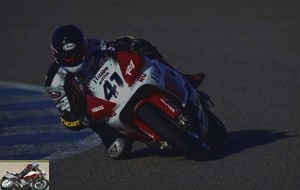 It took 2 years for this bike to become the benchmark, then disappear
It took 2 years for this bike to become the benchmark, then disappear
Cycle part
Because it looks so thin and small when driven, the R7 seems to change direction at least as well as a twin, despite its inevitably larger footprint and higher center of mass. If the thick saddle pad felt like it was sitting very high and the R7 was rather tall, it actually wasn’t. And even with the extra horsepower from the factory engine, the Yamaha comes out perfectly in turns, thanks to the grip offered by the ultra-long swingarm afforded by the gearbox layout, Ohlins shock absorber and rear Dunlop. 16.5 inches. Combined with the right steering geometry to choose from, this setup was crucial to Haga’s success. Too bad he could not do the same with the Michelin the following season in GP 500.
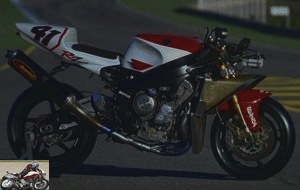 Haga’s Yamaha YZF-R7 laid bare
Haga’s Yamaha YZF-R7 laid bare
Braking
The Yamaha is braked brilliantly by its Nissin six-piston calipers and large 320mm discs from the factory kit. These slow the R7 down well at high speeds, aided by residual engine braking which, thanks to its slip clutch, leaves no trace of rear wheel dribbling. The Yamaha is really stable on heavy braking, its forward weight bias has no effect on mass transfers. With Haga’s soft settings at the front and rear of the Ohlins suspensions, the only time you notice this flexibility up front is on hard braking, like at the end of the main straight in Jerez, when with a classic riding style, it may seem that the front dives a lot and you risk a crash as you approach the turn. But it’s all part of the hardware package: Haga liked to be seated far enough forward to load the wheel to the fullest with his weight, with a lot of leverage on the pair of wide bracelets. It also used the rear brake a lot, both to prevent too much mass transfer and to slide the rear Dunlop in an inimitable and spectacular way..
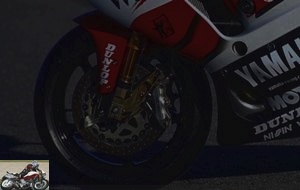 You have to be Haga to master the glide at this point on the R7
You have to be Haga to master the glide at this point on the R7
Conclusion
Sorry I’m just the understudy so you won’t see any pictures of me sliding down the R7 on the last corner of Jerez. It is a learned skill, not an art, with which ordinary pilots are not lucky enough to be born. The problem is, it’s also an art that dictates how to use this finely honed tool for your requirements, as arguably the R7 was after two years of development, specifically intended to meet Haga’s needs. This has brought positive spinoffs to SBK privateers and national level Yamaha teams around the world, but none have enjoyed the same level of success with the R7 as the factory team, not even in Japan where the Kawasaki Carbureted ZX-7RR remained the queen of 4-cylinder superbikes and retained the All-Nippon SBK Championship title.
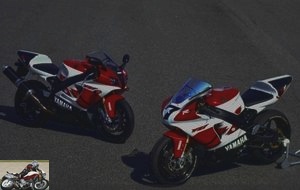 The road R7 and the one equipped with the Racekit
The road R7 and the one equipped with the Racekit
The Yamaha R7 is a motorcycle that went into premature hibernation without winning the world title for which it was developed. Could this have been a mission accomplished in 2001 if Yamaha had not ended its engagement in WSBK to focus on the GP OW-M1 (which with its 942cc 20-valve engine had a lot in common with the R7 from which it was almost certainly derived)? For having driven both almost simultaneously, I think that with Dunlop and Haga tires on the handlebars, Yamaha had every chance to win the title against the Honda / Edwards duo, instead of having to wait until 2009 and Ben Spies was in charge. But this is all speculation and we’ll never be sure…
Strong points
- Maneuverability
- Braking
- Motor
Weak points
- Mastery of skiing is imperative
- Hard clutch
The technical sheet of the Yamaha YZF-R7 OW-02
Related articles
-
OJ Yamaha YZR250 OWL5 motorcycle test
The 2000 GP250 World Champion 90 ° V-twin, 249 cc, 97 hp, 268 km / h, 97 kg In 2000, Olivier Jacque dazzled Grand Prix enthusiasts riding the Yamaha of…
-
Yamaha Tracer 700 GT motorcycle test
Joys of possibilities Twin-cylinder in-line, 689 cm3, 74.8 hp, 68 Nm, 200 kg all full, available in A2, 8,999 euros. The Yamaha Tracer 700 Gt! Here is a…
-
Yamaha YZR500 OW48R motorcycle test
Kenny Roberts’ 3rd title bike in 1980 4 cylinders in line, 2-stroke, 498 cm3, 102 hp, 135 kg This is the year of the pyramids in motorcycles, with a good…
-
Fashion victim ! The single-cylinder trail is out of fashion and that’s a shame. Because the Yamaha XTZ 660 Tenere remains the embodiment of the…
-
Winning return To those who doubted the involvement of Yamaha in enduro, despite its rich history and success, the new 250 WR-F opposes an end of…
-
The scooter missing between 250 and 530 cm3 in tune XMax 125, XMax 250, TMax 530…. one could have imagined that Yamaha would go hunting on the roads of…
-
Two-Temperaments ! At the end of the 1970s, when motorcycles with large-capacity multicylinder engines weighing a dead donkey have been in vogue for a…
-
The unfinished future The brand with three tuning forks, wishing to prove its lead in terms of technology and innovation, unveiled its 1000 GTS at the…
-
Yamaha VMax 1700 motorcycle test
The return of a legend The return of the good, the bad and the tonic-truante. Certain celestial objects cross our orbit according to a periodicity which…
-
200 hp at 13,500 rpm, 112 N.m at 11,500 rpm, 199 kilos with full fuel, from € 18,499 Is the Crossplane engine an advantage in road use ? Even if the…
749 cc, 172 hp, 162 kg dry, this is the Yamaha YZF-R7 OW-02 of Noriyuki Haga from the WSBK! And we tried it! What better way to start the year than to try out an exceptional motorcycle ?! A whole symbol and a legendary essay
A very nice article for a very nice motorcycle.
I own it and I confirm that driving it on the roads of France is a pleasure, both in the mountains and in the city. However, there is one point that you do not cover in your article and which severely fines it compared to its competitors. It’s about its reliability. Indeed, beyond the 20,000th kilometer, the motorcycle spends a good part of its time in the garage and we can not say that Guzzi’s after-sales service is very efficient..
Too bad because this bike could have given rise to vocations as a Guzzist
Yes, unfortunately, there is still work to be done on the after-sales service. There is a lot of progress, but it started so far…
Question reliability, I would be more nuanced. Some machines are badly affected by various breakdowns or breakages. But at BMW, there are also a lot of worries.
What are the problems you have encountered?